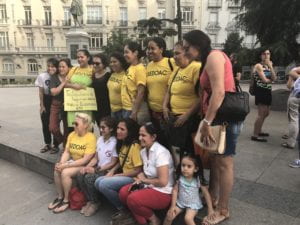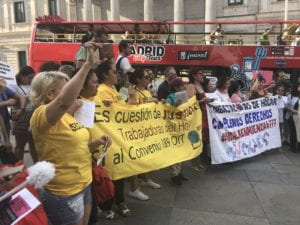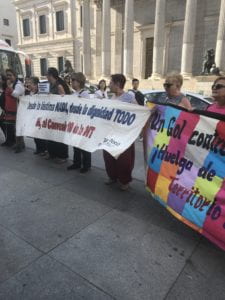SEDOAC works within the “field” of domestic workers rights throughout Spain. Over the past week, I have been able to see exactly how SEDOAC works within this context, and how a coalition of different domestic workers can work together as a collective movement in order to reach a wider audience and have a bigger influence. SEDOAC works within Grupo Turín, a group made up of different organizations that all work for the empowerment of domestic workers in Spain. The organizations involved have protests together, such as the protest on Wednesday against “La Enmienda 6777.” This amendment is currently being voted on in Congress.
La Enmienda 6777 would move the Convenio 189 OIT back. The Convenio 189 OIT is a Spanish congress meeting, designed to further the rights of domestic workers by giving them more rights and increasing wages. This meeting was designated for the the first of January, 2019, but right as Mariano Rajoy left office, he put forth a proposition to move the meeting until January of 2024, giving domestic workers five more years of almost no rights and protections under the Spanish government. #NOALAENMIENDA6777, or no to Amendment 6777, is the rallying cry of all the members of Grupo Turín, including SEDOAC. It is a concrete, immediate issue that all the organizations can agree on. All the organizations in Grupo Turín, no matter what their specific focuses are on, are currently participating in the same manifestations and protests against this amendment.
On Wednesday, the organizations of Grupo Turín did just that. I have uploaded some of the photos and videos I took during the protest, and the huge turnout was inspiring and only possible due to the multiple groups that showed up and brought their own supporters. Together they were able to stage an impressive demonstration in front of the congressional building, and each organization gained some visibility from the sheer size of the demonstration. For example, Carolina Elías, the president and founder of SEDOAC, was interviewed by television journalists and the event was widely publicized on social media. Although each individual organization may not have gotten specific recognition, their shared cause got much more recognition.
This amendment is an example of the best way that the coalition of domestic workers can work together despite different goals. There are, however, other examples of how it can be difficult or even impossible to consolidate the goals of everyone in the field. A difference that was made very clear on the protest on Wednesday was the difference between “externas,” or domestic workers that live outside employers’ homes, versus “internas,” domestic workers that live inside their employers’ homes. In fact, one of the chants at the rally was “no estamos todas, faltan las internas,” meaning “not all of us are here, we’re missing the internas.” The women who work inside their employers’ homes work much, much longer hours and are not able to protest in the same way, so they often have to rely on other, more privileged (though still not privileged) domestic workers to do the protests for them and in their name. Obviously, if a whole subsection of domestic workers are not there, it is very difficult to hear their voices and their goals in an overall platform.
The other difficulty in organizing that many women in SEDOAC have brought up is the difference between Spanish domestic workers and foreign domestic workers. Because Spanish nationals have a certain amount of government protections, they can afford to not take the worst, most exploitative jobs, such as working from inside their employers’ homes. Foreign women do not receive government benefits, and so they often must take the jobs that are available, which are often internal jobs. Spanish women can receive welfare and other government benefits if they either do not have a job or are not making enough money to support themselves, meaning they have a security blanket that foreign women do not have. Thus, in many discussions, foreign women have goals such as integration of domestic workers into the formal workplace and integration of foreign women into the welfare system that is not a priority for Spanish domestic workers. The individual goals of certain organizations with Grupo Turín, such as SEDOAC, vary from each other, making it difficult to create collective movements.
While domestic workers of all classes and backgrounds can often come together in Spain on certain issues, it can still be difficult for all the different organizations that work with domestic workers’ rights to come to agreements on their platforms and views. The advantage in numbers is a large one, but for groups like SEDOAC, it must be done while still keeping in mind the goals of their members, and the more exploited voices that are often not able to attend movements such as protests and rallies. Keeping these women in mind while trying to maintain strength in numbers is a difficult task, and one of the key issues for organizations like SEDOAC that represent marginal communities within marginal communities must face.




“Grupo Turín.” Empleo De Hogar y Cuidados,
congresoempleodehogarycuidados.es/grupo-turin-quienes-somos/.
“NO a La Enmienda 6777: Plenos Derechos Para Trabajadoras Del Hogar.” Servicio Jesuita a
Migrantes, 20 June 2018, sjme.org/decimos-no-a-la-enmienda-6777/.

This is great! You’ve done a lot with this question and demonstrated the ways in which a theoretical understanding of intersectionality can be difficult to implement in the sphere of on-the-ground organizing. While we often speak of intersectionality only in terms of race, sexuality, and gender, it also brings in questions of class and citizenship, which come up here. This actually reminds me a lot of the problems of organizing workers in the U.S. in the late-19th century. Managers found great ways of dividing the early labor movements along ethnic and racial lines and, of course, African-Americans were often excluded from unions even then. (Later, Puerto Ricans faced similar discrimination within the labor movement.) This is not to condemn labor unions, but rather to point out that coalition building around the rights of workers has often faced these struggles. Might it be useful to look at any examples of labor organizing around other trades in Spain to see what happened with them?